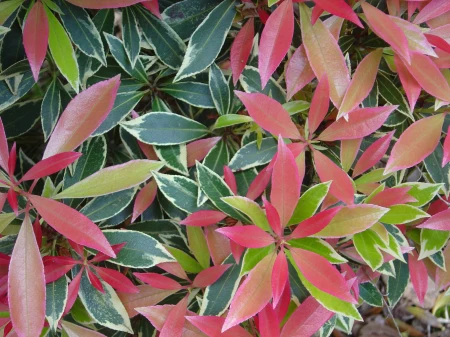Two ‘Flaming Silver’ pieris (Pieris japonica ‘Flaming Silver’, below) in part shade in the front garden have long been plagued by lace bugs, though much of the damage occurred when they were less shaded. One pieris has been overtaken by a wide spreading leatherleaf mahonia (Mahonia bealei) so that it’s barely visible, though if it was healthier it wouldn’t be any trouble at all to prune the mahonia. But, why bother?
Many varieties of pieris are susceptible to lace bugs, and it seems ‘Flaming Silver’ is a magnet for these pests. On the far side of the garden ‘Scarlet O’Hara’ suffers only slightly in nearly full sun, and from my experience it’s also more vigorous and less likely to have problems in poorly drained clay soils. The reason for growing ‘Flaming Silver’ of course, is the variegated foliage, and at its best this is quite extraordinary. While dormant the foliage has a distinct creamy white and green variegation, and spring growth is red (below) when planted with some portion of a day of direct sun.

Deer don’t bother any of the pieris, even those planted along the margin of brambles and forest where deer hang out during daylight hours. But, between problems with lace bugs and an intolerance for damp clay soil, some of the varieties of pieris are an iffy proposition. Lace bugs are easily controlled if you are willing to use a systemic insecticide, but I don’t. ‘Flaming Silver’ is a splendid evergreen, with excellent foliage and early spring flowers, but if it fades away over the years because it requires pesticide treatments, I’ll just have to find something else to fill the spot instead.
In the past year I’ve had some problems with deer and the gold aucubas (Aucuba japonica ‘Gold Dust’, below). Last winter I neglected to spray the garden’s evergreens with a repellent as I typically do in November. When it finally occurred to me I decided that damage has already been done, half the aucubas and azaleas have been eaten, so why not experiment to see what happens? Well, what happens is that the deer get more desperate for food as the winter progresses, and before the start of February they’ve eaten every leaf they can get to. I’m not quite certain what I was trying to prove (except to avoid work and stay out of the cold), but despite the fact that neither aucuba or azaleas are the preferred diet of deer, in winter when there is less foliage deer will readily eat every leaf.
So, the spring started with no leaves on the azaleas or aucubas, and along with foliage deer nibbled the branch tips so there were few flowers on the azaleas in the spring. Of course, everything recovered nicely, but the aucubas will take another year to regain their full vigor, except one large shrub that is planted in a nook along one of the garden’s ponds so that deer generally avoid it completely. Fortunately, this aucuba is the most visible, so while the others are sparse, this one is tall and full and particularly appreciated for its bright foliage when other plants are dormant.
Aucuba is regarded as only marginally cold hardy for northwestern Virginia, but even twenty some years ago when temperatures dipped more regularly below zero, young plants seldom showed any signs of cold damage. The mass of gold speckled evergreen foliage is particularly useful in shaded areas, and even in dry shade the aucubas manage quite well (though they are slower than in deeper soils). The aucubas were sprayed with a repellent several weeks ago, so I expect no further problems.